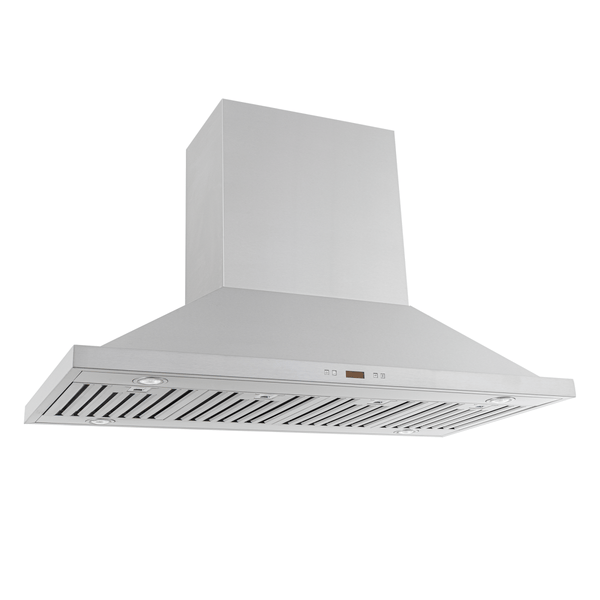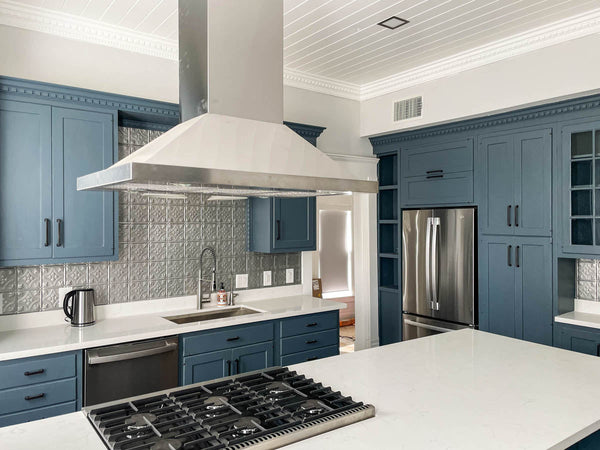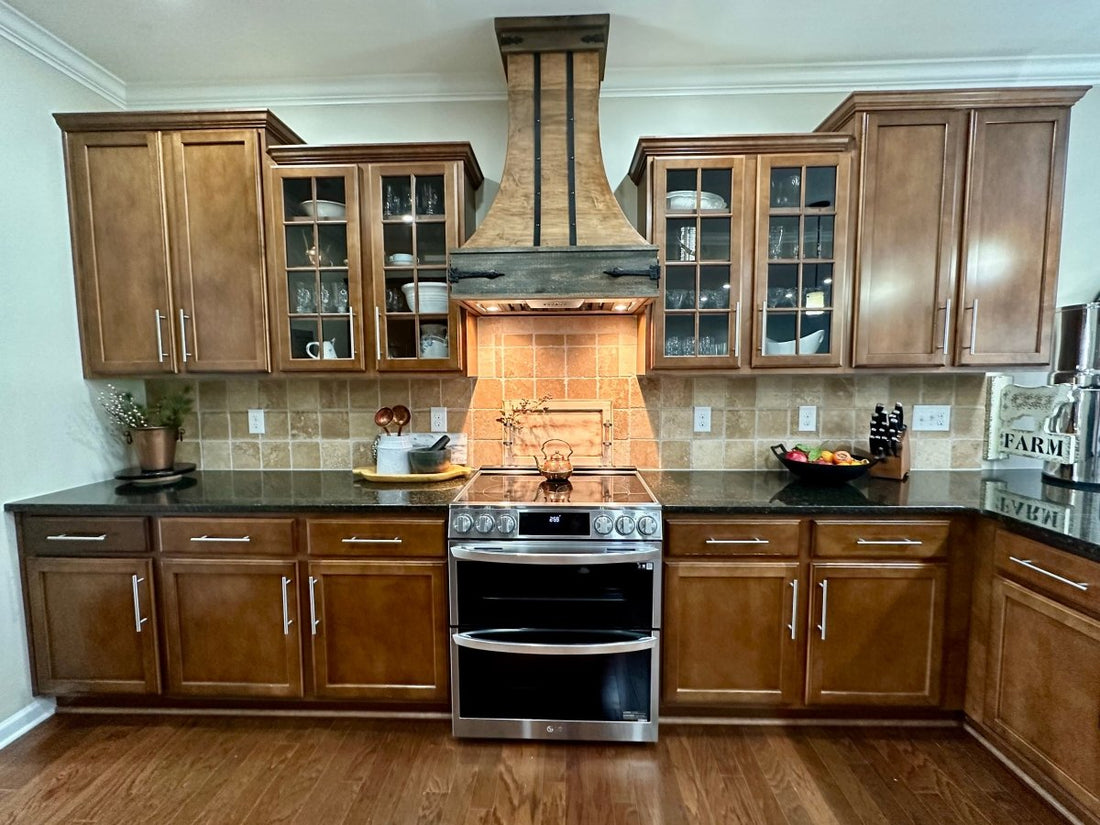To determine what range hood you need, you have to consider many factors:
- Size
- Mounting Location
- Ventilation
- Filters
- CFM
- Noise
- Height
We’ve created a video that goes over these seven aspects of your range hood and how they will impact your purchase in detail. It’s also important to consider whether you want an indoor or outdoor hood.
We’ll unpack each of these seven factors to consider when choosing the right range hood for you – and give you some helpful purchasing tips along the way. At the end of the article, we’ll discuss some of the most common questions asked about range hoods, so be sure to stick around.
Range Hood Size

Indoor Hoods
The most important thing to consider when determining your range hood size is its coverage of your cooktop. To maximize the efficiency of your wall mounted range hood, it should extend three inches past your cooktop on each side.
Island hoods require more coverage over your range. They should extend between three to six inches past your cooktop on each side. Why? Well, unlike wall mounted hoods, island hoods are exposed to your kitchen air from all sides. You’ll need more coverage to vent grease, dirt, and other toxins outside your home.
For example, if you have a 30” range, a 36” wall mounted range hood (3” longer than the range on each side) is the perfect size. It will vent unwanted contaminants out of your kitchen with incredible efficiency.
If you are installing an island hood over a 30” range, the ideal size is up to 42” (6” past your cooktop on each side).
The most popular type of island hoods are tapered, but you'll also find rectangular hoods like our PLFI 755 or flush hoods like our Island Pro model.
Outdoor Hoods

If you’re installing an outdoor hood, it will need to be larger than an indoor hood. Outdoor grills radiate more intense heat than an indoor range; in turn, your grill will produce more harmful toxins.
To vent out these additional contaminants, size your hood between 6” and 12” larger than your cooktop on each side.
For example, if you own a 36” outdoor range, the best hood size is between 48” (12” wider) and 60” (24” wider).
For more information on sizing your range hood, check out our comprehensive sizing guide.
Where to Mount Your Range Hood

Another thing to consider is where you want to mount your hood. The style of your range hood essentially chooses this location for you.
Regardless of the type of hood, mount it between 28 and 36 inches above the cooktop for indoor applications, and between 36 and 42 inches above the cooktop for outdoor applications.
Check out our detailed mounting height guide here for more information.
Here are some of the different options available to you when choosing a range hood for your home.
Under Cabinet Range Hoods

Under cabinet range hoods are installed under the cabinets in your kitchen. The ductwork can run horizontally through your wall or vertically through your roof, hidden by your cabinets
Wall Mounted Range Hoods

Wall mounted range hoods, as the name suggests, will mount up against a wall in your kitchen, over your cooktop. As with under cabinet hoods, your ductwork will be hidden, but this time by a chimney.
Island Range Hoods

Island hoods are installed from your ceiling, typically in the middle of your kitchen over an island cooktop.
Range Hood Inserts or Liners

Range hood inserts, also called liners, are designed to fit into your premade custom hood or under your cabinets. They’re easy to install and will look great in any kitchen.
Outdoor Range Hoods

Outdoor range hoods are often wall or island hoods over 1200 CFM manufactured in a more durable stainless steel to withstand the weather and intense heat of your grill.
Ventilation - Ducted or Ductless?

You’ll also want to consider how to ventilate your range hood. Here, you have two options: ducted and ductless.
Range Hoods that Vent Outside (Ducted)


Ducted hoods are range hoods that vent your kitchen air through ductwork and outside your home. This is the best option to maximize the filtering of grease, dirt, smoke, and other unwanted contaminants out of your home.
Ductless or Recirculating Range Hoods
If you cannot duct your hood to the outside, you’ll want to look into purchasing a ductless hood.
If you live in an apartment or condo, you may not have access to the ceiling or permission to install custom ductwork that vents to the outside. Then a recirculating hood is your best option. These hoods suck in your kitchen air through charcoal filters and then recirculate the cleaner air back into your home.
Check out our extensive review on the best range hoods for your apartment (best ductless hoods) to find the perfect fit for your kitchen.
Range Hood Filters

Often you won’t have a choice when it comes to range hood filters; most models only include one type of filter.
Most of our ducted hoods at Proline come with stainless steel baffle filters, while some include aluminum mesh filters. Recirculating hoods come with replaceable charcoal filters.
Ducted Hoods
Ducted hoods come with either stainless steel baffle filters or aluminum mesh filters.
Stainless steel baffle filters trap grease in baffles as it travels through your hood and into your ductwork. Aluminum mesh filters accumulate grease in aluminum mesh.
Because of the way that mesh filters trap grease, they need to be washed more frequently than stainless steel baffle filters. Both of these filters are dishwasher-safe, making cleaning convenient.
Outdoor hoods are ducted hoods that use either stainless steel baffle or aluminum mesh filters.
The most important thing to be aware of regarding the filters for your outdoor hood is how often you clean them. Because grills produce more heat and unwanted contaminants, your filters need more frequent cleaning.
For more information on filters and how to clean them, check out the links below.
How to Clean Range Hood Filters
Recirculating Hoods

Recirculating hoods use replaceable charcoal filters to capture grease, dirt, and trap odors from your kitchen air.
If you use a recirculating kit to convert your hood to ductless, it will use either a stainless steel baffle filter or aluminum mesh filter combined with a charcoal filter.
Click on the link below to learn more about how often you should replace your range hood filters.
How often should I replace my range hood filters?
CFM
Hood power, measured in cubic feet per minute (CFM) is crucial when choosing a range hood. The more often you cook, the higher CFM you’ll want for your range hood. Also, if you cook a lot of greasy, fried, spicy, or Asian foods that produce a lot of heat and odors, or have a really powerful hot cooktop, a high-CFM hood is your best option.

What’s a high CFM hood? Generally, hoods from our professional series pull 900 or more CFM of air. These hoods are also recommended for outdoor environments, since grills produce high heat and your hood will be further from your cooktop.
Use a professional hood if you ductwork with two or more elbows. The extra power will accommodate for the added resistance due to the turns in your ductwork.
Noise
The noise level of your range hood depends on the CFM. Range hood noise is commonly measured in sones.
At Proline Range Hoods, our products produce a maximum of 7-8 sones on their highest speeds,which is equivalent to normal conversation. For more information on sones, take a look at this article; it also includes a helpful sones to decibels chart.
Most of the noise from your range hood is produced by its single or dual blowers, while the rest of the noise comes from your kitchen air moving into the hood and through your ductwork. If you use a local blower, your hood will produce more noise since the blower will be inside your range hood.
If you want a quieter kitchen environment, consider a remote blower, which is installed within your ductwork, further away from your range hood.
Remote blowers are especially useful for outdoor hoods, which will produce more noise since they need to filter out more contaminants produced by your grill.
Range Hood Height

The last important factor to consider is the height of your range hood. This will depend on two things: the distance between your cooktop and your range hood and the distance between your cooktop and your ceiling.
Once you’ve determined the distance between your cooktop and range hood as well as your ceiling, subtract them. Here’s an example below to help you with the calculations.
Distance between cooktop and ceiling: 60 inches
Distance between cooktop and range hood: 30 inches
60 inches - 30 inches = 30 inches (range hood height, including chimney)
So, for this example, you’ll want the height of your range hood and chimney(s) to be 30”.
The 30” describes the height of the entirety of your hood. So if you want a chimney as well, the chimney and your range hood will together have to be 30”.
For additional info on chimneys – whether you’re buying a new hood or looking to retrofit a chimney on an old hood – check out our detailed article here.
At Proline, our extensions accommodate ceiling heights between 7’ and 12’.
That wraps up our guide – hopefully you have the tools to decide what range hood is best for you.
Don’t go quite yet. We’ll answer some of the most common questions that we encounter here at Proline before finishing this article.

What size range hood do I need?
For indoor hoods, purchase a hood that is six inches wider than your range. For outdoor hoods, purchase a hood that is between 6 and 12 inches wider than your range.
What size range hood do I need for a 30 inch cooktop?
For a 30 inch cooktop, install a range hood that is at least 36” wide indoors and 42” wide outdoors.
Should my range hood be wider than my cooktop?
Yes. Indoor hoods should be 6” wider and outdoor hoods should be 6” to 12” wider than your cooktop. This gives you optimal coverage. The hood will capture nearly all of the grease, dirt, smoke, and cooking fumes from your kitchen air.
What size range hood do I need for a 36 inch cooktop?
For a 36” cooktop, purchase at least a 42” indoor hood and a 48” outdoor hood.
What CFM do I need for an island range hood with a 12’ ceiling?
With a 12’ ceiling, your kitchen air has to travel a long way to reach the outside of your home. We recommend at least 1200 CFM for an island hood with a 12’ ceiling.
What size vent hood do I need for a 48 inch range?
For a 48” range, purchase at least a 54” range hood for indoor use and a 60” hood for outdoor use.
What range hood ductless CFM do I need?
Purchase a ductless hood that is at least 600 CFM to allow the charcoal filters to capture grease and dirt from your kitchen air at maximum efficiency.
What size range hood insert do I need?
Follow the same principles to size your range hood. Add 6” to the width of your range and up to 12” for outdoor use. The only difference is that you need to subtract 2” after the fact. Inserts are sized 2” smaller than your typical vent hoods to fit comfortably inside your custom hood.
For example, for a 30” range, a 36” hood is ideal. Then, subtract 2” and you get 34”. So a 34” hood insert or larger is a great fit for a 30” range.
For outdoor applications, go with an insert two sizes larger than your range. In the above example, a 40” insert would work great over a 30” outdoor grill.
What range hood do I need for a gas range?
The safe bet is to go with a hood that is 900 CFM or higher for your gas range. The larger the range, the more CFM you’ll need.
If you own a range against a wall, install a wall hood, under cabinet hood, or range hood insert. For a range on a kitchen island, buy an island hood.
For more information on the best range hoods for gas stoves, check out our ultimate guide.
Hopefully these questions helped you decide what range hood you need! If you have any more questions or concerns, feel free to call our customer service team at (877) 901 - 5530. Thanks for reading!
Related Articles
4 Best Outdoor Vent Hoods from Proline
Ultimate 30” and 36” Range Hood Guide
How many CFM do I need for my range hood?











